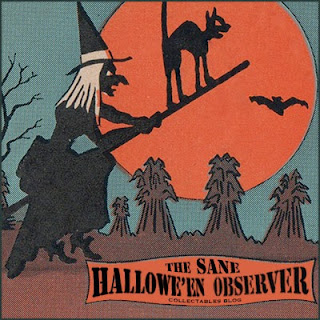Midcentury Halloween Candies

E. Rosen Company’s Moon Pop, boxed with a set of 5-card Trix or Treats sucker holders from the pages of Sears 1950 Fall and Winter Catalog for the Chicago market.
One of the shorter pieces in The Halloween Retrospect, Vol 2, (second book in a research series for vintage Halloween collectors) is “Trix or Treats at Sears: Rosen in Midcentury Midseason Fall Catalogs” (p. 28). This brief yet image-driven article offers a review of Rosen’s trading-card style sucker holder, and with notes on variations. To do so, the article offers vintage clippings that reveal market availability in Halloween candy sections of Sears catalogs – and although the article focuses on the cards, this supporting blog entry adds a bit of extra info about the Moon Pop often paired with those sets.
Sets 1 through 4 are depicted in The Halloween Retrospect, Volume 2 (together with era catalogs, and a table to record sightings), but the sets themselves have posted earlier to The Sane Halloween Observer in this 2014 entry “Variation on Trix or Treats“.
The catalog clipping at top comes from Sears 1950 Chicago Fall and Winter Catalog and features Rosen’s 54 Tricks-or-Treats assortment sold in sets of 9 articulated Moon Pops and 45 slot cards. The catalog (p. 241) reads:
[A] 54 Tricks-or-Treats to thrill young pranksters when they ring your doorbell on Halloween. A delightful assortment of Halloween pops… 54 in all. Set consists of 9 large Moon pops, 45 Tricks-or-Treats cards, 9 each of 5 different designs, each with gay Halloween verse, and 45 wax-wrapped pops which can easily be slipped into the cards. All pops have paper safety sticks. Set is packed in a vividly colored Halloween box. (We cannot guarantee shipment after October 31.) Shpg. wt. 2 lbs 87HF8060…. 54 for 89c.
But note, there is some important additional data in the article, and THR, V2 provides a workbook-style table that the reader may use to mark sightings. Why? While reviewing catalog spots (1946-1954) it appears cards sets (1-4) aren’t entirely linear (one giving way to another) across time. Instead the sets appear to have overlap in print runs and/or market availability in neighboring years. The Halloween Moon Pop is part of that story – as it is paired with the various cards.

A digital recreation of how Halloween Moon Pop (original item from THR archive collection) appears with witch’s cape in slot, sucker in place. The mock-up is provided here since old paper has a tough time surviving the tight tolerances needed to reconstruct the item in actual 3D.
Side note: the 1950 Sears of Chicago clipping here shows but one selection of Rosen candies (above) with more seen in THR, V2. Other Rosen treats in the illustrated catalog spot include a box set of Four Plastic Toys (that is – a horse, snowman, witch, and clown candy holders in larger size) and a set of Ten Plastic Toys (that is – 5 witches and 5 cats as smaller sized candy holders).
E. Rosen Company
E. Rosen Company (aka School House Candy) has left for today’s vintage collector (of all holidays and seasons) a legacy of nostalgic packaging designs (for their candies) in both paper as well as in plastic (as Rosbro Plastics). And while THR, V2 does not review company history – a few interesting reads have been discovered and are shared here:
1— The first item of interest is “School House Candy” (link here) excerpted and adapted from Elegy for a Disease: A Personal and Cultural History of Polio (2006) by Anne Finger. The story is a personal remembrance as one with physical challenges looking to an employment rite of passage (as a 1960s Providence teenager). While content is more about the individual than a company history, still, the descriptions of the factory and employee experience is relatable and insightful.
2— The second item is by Raina Fox (2016): “Shoelaces and Marshmallow Bunnies: Memory, Adaptation and Reuse at Pawtucket’s Hope Webbing Mill” (link here) from Rhode Island History, Winter/Spring 2016, Vol. 74 (1). This piece offers some company history in relation to the Hope Webbing Mill building (1889 to today) home to E. Rosen (1956–1998). In doing so, the author provides a greater perspective of the Pawtucket community in transformation.
3— The third item is from company founder Simon Rosen (1993) “How School House Candy Started” (link here) in Rhode Island Jewish Historical Notes Vol. 11(3), p. 388 offering what are apparently condensed memoirs (dating 1912 to retirement in 1977). And although the tales are interestingly entertaining, the piece will fly too quickly for a serious researcher as it becomes very scant in details around 1936. Perhaps there exists a longer version of these memoirs?

E. Rosen Company aka Rosbro catalogs 1955 and 1956 (above cover) record the usual suspects of midcentury Halloween plastic containers – witches on cycles, witches on rockets, cats on wheels, scarecrows on wheels, elephants, Pirate’s Auto, etc.
Volume 2, THe Halloween Retrospect
If the information shared here sounds interesting to you, below are additional sample images from the new research book The Halloween Retrospect, Volume 2 — including a peek at pages from the Rosen article:

The first article (in THR, V2) fills the majority of pages for fans of Dennison (and owes much to help from archives at Framingham History Center) – see also “Dennison Halloween“, “Dennison Publications“, and “The Gatekeeper of Data“. THR’s various commentaries explain and translate Dennison serial numbers appearing on their vintage publications, and includes a bonus insert of full-color fold-out poster survey of Halloween-themed titles 1909-1935 (from THR’s archive library). The rest of the content includes: a piece discussing B. Shackman & Co. catalogs, a piece researching certain German imports (on the book cover), and the piece (mentioned in this blog entry) reviewing midcentury midseason catalogs by Sears with E. Rosen Company sucker cards.
Here is a link to more website info about The Halloween Retrospect, Volume 2 (a new research-based guide on the vintage market of for Halloween collectors) and here is a direct link to The Halloween Retrospect book sales to purchase a copy via Etsy checkout.




